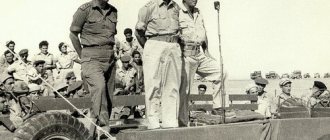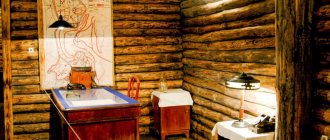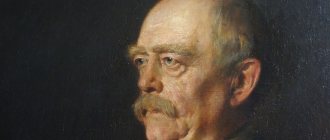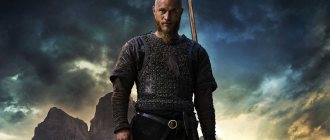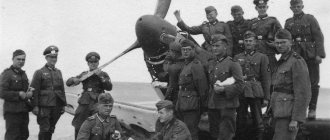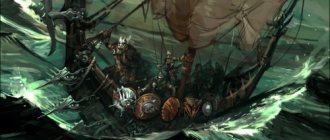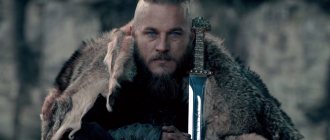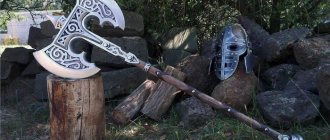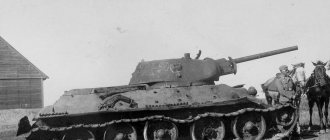Viking Age
And their songs about heroes and travelers - sagas and the Icelandic parliament, the Althing - the first people's assembly in Europe, have survived to this day.
The beginning of the Viking Age is considered to be 793. This year there was a famous attack by the Normans on a monastery located on the island of Lindisfarne (north-east of Great Britain). It was then that England, and soon the whole of Europe, learned about the terrible “northern people” and their dragon-headed ships. In 794 they “visited” the nearby island of Wearmus (there was also a monastery there), and in 802-806 they reached the Isles of Man and Iona (west coast of Scotland)
Life of the inhabitants of Scandinavia
In their homeland, the Vikings lived in large peasant dwellings. Under the roof of one such building there was room for a family that included three generations at once. Children, parents, and grandparents lived together. This custom was an echo of the tribal system. Houses were built from wood and clay. The roofs were turf. In the central large room there was a common fireplace, behind which they not only ate, but also slept.
Even when the Viking Age began, their cities in Scandinavia remained very small, inferior in size even to the settlements of the Slavs. People concentrated mainly around craft and trade centers. Cities were built deep in the fjords. This was done in order to obtain a convenient harbor and, in the event of an attack by an enemy fleet, to know in advance about its approach.
Scandinavian peasants dressed in woolen shirts and short, baggy pants. The Viking Age costume was quite ascetic due to the shortage of raw materials in Scandinavia. Wealthy members of the upper classes could wear colorful clothing that made them stand out from the crowd, showing wealth and status. A woman's costume of the Viking Age necessarily included accessories - metal jewelry, a brooch, pendants and belt buckles. If a girl was married, she put her hair in a bun; unmarried girls tied their hair up with a ribbon.
First sack of London
Twenty years later, the Normans gathered a large army for a campaign against England and France. In 825 the Vikings landed in England, and in 836 London was sacked for the first time. In 845, the Danes captured Hamburg, and the city was so devastated that the episcopate located in Hamburg had to be moved to Bremen. In 851, 350 ships again appeared off the coast of England, this time London and Canterbury were captured (and of course plundered).
Creation of the Norman State of Dunloe
In 866, a storm carried several ships to the shores of Scotland, where the Normans had to spend the winter. The following year, 867, the new state of Danelaw was formed. It included Northumbria, East Anglia, part of Essex and Mercia. Danlo existed until 878. At the same time, a large fleet attacked England again, London was captured again, and then the Normans moved on to France. In 885, Rouen was captured, and Paris was under siege (in 845, 857 and 861, Paris was already sacked). Having received the ransom, the Vikings lifted the siege and retreated to the northwestern part of France, which in 911 was transferred to the Norwegian Rollon. The region was named Normandy.
European campaigns
Having crossed the Atlantic and discovered new lands in the west, the Vikings successfully moved east: they passed through all of Europe and penetrated into Asia. Danish Vikings settled in the northeast of the British Isles, raiding the coasts of Italy and North Africa.
Norwegian Vikings, who settled at the mouth of the Seine and other rivers in northern France, obtained rights to the province of Rouen from the King of France, which was later called Normandy. The Swedes followed trade routes from the Baltic to the Black Sea, and from there to Constantinople, paving the way from the Varangians to the Greeks along the rivers of Ancient Rus'. Moving from one river to another, the boats were dragged overland.
Conquest of England in the 10th century
At the beginning of the 10th century, the Danes again tried to capture England, which they succeeded only in 1016. The Anglo-Saxons managed to overthrow their power only forty years later, in 1050. But they did not have time to enjoy freedom. In 1066, a huge fleet under the command of William the Conqueror, a native of Normandy, attacked England. After the Battle of Hastings, the Normans reigned in England.
Links[edit]
Footnotes [edit]
- The word "Viking" is a rebirth of history; it was not used in Middle English, but it was revived from Old Norse vikingr
"freebooter, sailor, pirate, viking", which is usually interpreted as the correct meaning of "one who came from the fjords of
Vik
, bay, small bay" (cf. Old English
wic
, Middle High German
wich
"bay" and second element in Reykjavík).
But Old English wicing
and Old Frisian
wising
are almost 300 years older and probably derive from
wic
"village, camp" (temporary camps were a feature of Viking raids), related to Latin
vicus
"village, dwelling".[3] - ↑
Graham-Campbell and Batey suggest that "... the real Vikings [are] those who took part in Viking raids... A Viking base is thus the base from which the Vikings raided, but a Norse settlement in Scotland is a settlement occupied by humans Scandinavian origin..." [4] - ↑
The Anglo-Saxon Chronicle Worcester MSS D for 948 AD says: "And while the king [Eadred] was on his way home, the invading army [Eric Bloodaxe] which was at York overtook the king's army at Castleford and great there was slaughter." - The Anglo-Saxon Chronicle says that BLOODAXE was "expelled" from Northumbria; however, other sources claim that he was also killed" [35]
Quotes [edit]
- Keynes 1999. item 460.
- ^ ab Richards 1991. clause 9.
- Internet dictionary of etymology. Retrieved February 12, 2022. Archived September 7, 2014, at the Wayback Machine.
- ^ abc Graham-Campbell and Batey 1998. clause 3.
- ^ a b Blair 2003. pp. 56–57.
- Blair, Peter Hunter (2003). An Introduction to Anglo-Saxon England. Anglo-Saxon Studies (revised ed.). Cambridge University Press. paragraph 57. ISBN 9780521537773. Retrieved April 30, 2022. A wealth of evidence, among which some items from Sutton Hoo feature prominently, indicates that England was within reach of Scandinavian foreign contacts before the Viking attacks began.
- ^ a b c Blair 2003. paragraph 55.
- Graham-Campbell and Batey 1998. clause 5.
- Graham-Campbell and Batey 1998. pp. 5–7.
- Graham-Campbell and Batey 1998. pp. 14–16.
- Graham-Campbell and Batey 1998. paragraph 18.
- ^ a b c Richards 1991. clause 13.
- Graham-Campbell and Batey 1998. clause 1.
- Richards 1991. clause 11.
- ^ ab Graham-Campbell and Batey 1998. paragraph 32.
- Richards 1991. clause 12.
- Hunt, Katie (2017). Herring: A World History. Edible series. London: Reaction Books. paragraph 37. ISBN 9781780238678. Retrieved January 24, 2022. In Scandinavia, herring and cod were the main fish of the Viking Age. Many historians suggest that the Vikings went primarily to fish for cod and herring. The conquest of land was a continuation of their quest for fish and fishing grounds. […] Vikings pursued herring not only off the coasts of Denmark, Norway and Sweden, but also on the east coast of England and the Orkney Islands of Scotland. Historians believe that giant schools of herring in England attracted marauding Vikings to its eastern shores in the eighth century.
- ^ a b c Blair 2003. paragraph 63.
- ^ B s d e g Richards 1991. paragraph 16.
- Graham-Campbell and Batey 1998. paragraph 24.
- Jump up
↑ Blair 2003. paragraph 66. - Jump up
↑ Blair 2003. paragraph 68. - Christopher Wright (1975). Kent for many years
. paragraph 54. ISBN 0-7134-2881-3. - Anglo-Saxon Chronicle
- ^ abc Harrison and Svensson 2007: 199
- Jansson 1980: 34.
- ↑
Harrison and Svensson 2007: 198. - Recording Sö 166 in Rundata 2.0 for Windows.
- Richards 1991. paragraph 17.
- ^ B s d e g h Richards 1991. paragraph 20.
- Starkey 2004. p.51
- Horspool 2006. paragraph 102
- ^ abc Peter Sawyer (2001). The Oxford Illustrated History of the Vikings
. pp. 58–59. ISBN 978-0-19-285434-6. - Richards 1991 p. 22
- Pearson 2012. paragraph 131
- Panton 2011. paragraph 135.
- Richards 1991. pp. 11–12.
- ^ a b c d Richards 1991. paragraph 24.
- "Saint Brice's Day Massacre". Historical Britain
. Retrieved June 7, 2022. - Jump up
↑ Howard 2003, pp. 64–65. - Jump up
↑ Howard 2003, pp. 66–67. - ^ a b c Richards 1991. paragraph 28.
- https://www.historynet.com/last-of-the-vikings-stamford-bridge-1066.htm
- Graham-Campbell and Batey 1998. clause 2.
- ^ a b c Blair 2003. paragraph 64.
- Richards 1991. clause 15.
Bibliography[edit]
- Blair, Peter Hunter (2003). An Introduction to Anglo-Saxon England
(3rd ed.). Cambridge, UK and New York, USA: Cambridge University Press. ISBN 978-0-521-53777-3. - Crawford, Barbara E. (1987). Scandinavian Scotland
. Atlantic Highlands, NJ: Leicester University Press. ISBN 978-0-7185-1282-8. - DeVries, Kelly (2003). Norwegian invasion of England in 1066
. Woodbridge, Suffolk: Boydell Press. ISBN 1-84383-027-2. - Graham-Campbell, James and Batey, Colleen E. (1998). Vikings in Scotland: An Archaeological Site
. Edinburgh: Edinburgh University Press. ISBN 978-0-7486-0641-2. - Horspool, David (2006). Why did Alfred burn the cakes
? London: Profile Books. ISBN 978-1-86197-786-1. - Howard, Ian (2003). "The Invasions of Suin Forkbird and the Danish Conquest of England, 991–1017" (illustrated ed.). Boydell Press. ISBN 9780851159287.
- Richards, Julian D. (1991). Viking Age England
. London: B. T. Batsford and English Heritage. ISBN 978-0-7134-6520-4. - Keynes, Simon (1999). LaPidge, Michael; Blair, John; Keynes, Simon; Scrugg, Donald (ed.). "Vikings". Blackwell Encyclopedia of Anglo-Saxon England
. Oxford: Blackwell. pp. 460–61. - Panton, Kenneth J. (2011). Historical Dictionary of the British Monarchy
. Plymouth: Scarecrow Press. ISBN 978-0-8108-5779-7. - Pearson, William (2012). Eric Bloodaxe: His Life and Times: The Royal Viking in His Historical and Geographical Setting
. Bloomington, IN: AuthorHouse. ISBN 978-1-4685-8330-4. - Starkey, David (2004). Monarchy of England
.
I
. London: Chatto & Windus. ISBN 0-7011-7678-4.
Division between Norwegians and Icelanders
In 861, the Scandinavians learned about Iceland from the Swede Gardar Svafarsson. Soon after, in 872, the unification of Norway by Harald Fairhair began, and many Norwegians fled to Iceland. According to some estimates, between 20,000 and 30,000 Norwegians moved to Iceland before 930. Later they began to call themselves Icelanders, thus distinguishing themselves from the Norwegians and other Scandinavian peoples.
Eirik Raud (Red) founder of the Brattalid settlement
In 983, a man named Eirik Raud (Red) was exiled from Iceland for three years for murder. He went in search of a country rumored to have been seen to the west of Iceland. He managed to find this country, which he called Greenland (“Green Country”), which sounds rather strange in relation to this snowy and cold island. In Greenland, Eirik founded the settlement of Brattalid.
Vinland Leif Eiriksson son of Red discovered Boston
In 986, a certain Bjarni Bardsson sailed from Iceland, intending to get to Greenland. He stumbled upon unknown land three times until he reached the southern coast of Greenland. Having learned about this, Leif Eiriksson, son of Eirik Raud, repeated Bjarni's journey, reaching the Labrador Peninsula. Then he turned south and, walking along the coast, found an area he called “Vinland” (“Grape Country”). Presumably this happened in the year 1000. According to the results of work carried out by scientists, Leif Eiriksson's Vinland was located in the area of modern Boston.
Leif's brothers: Torvald and Thorstein
After Leif's return, Thorvald Eiriksson, his brother, went to Vinland. He lived there for two years, but in one of the skirmishes with local Indians he was mortally wounded, and his comrades had to return to their homeland.
Leif's second brother, Thorstein Eiriksson, also tried to reach Vinland, but he was unable to find this land.
There were only about 300 estates in Greenland. The lack of forest created great difficulties for life. The forest grew in Labrador, which was closer than in Iceland, but everything needed had to be brought from Europe, due to the very difficult conditions of navigation to Labrador. Settlements existed in Greenland until the 14th century.
Archaeological evidence[edit]
Norwegian settlers in the British Isles left behind remnants of their material culture, which archaeologists have been able to excavate and interpret during the 20th and 21st centuries. Such Scandinavian evidence in Britain consists mainly of Scandinavian burials performed in Shetland, Orkney, the Western Isles, the Isle of Man, Ireland and north-west England. [45] Archaeologists James Graham-Campbell and Colleen E. Batey noted that it was on the Isle of Man that Norse archeology was "astonishingly rich in quality and quantity". [4]
However, as archaeologist Julian D. Richards has commented, the Scandinavians in Anglo-Saxon England "can be elusive to the archaeologist" because many of their houses and graves are indistinguishable from those of other peoples living in the country. [2] For this reason, historian Peter Hunter Blair has noted that in Britain the archaeological evidence for Scandinavian invasion and settlement was "very slight compared with the corresponding evidence for Anglo-Saxon invasions" of the 5th century. [45]
Viking History
VIKINGS - (Normans), sea robbers, immigrants from Scandinavia, who committed in the 9th–11th centuries. hikes up to 8,000 km long, perhaps even longer distances. These daring and fearless people reached the borders of Persia in the east, and the New World in the west.
Origin of the word Viking
The word “Viking” goes back to the Old Norse “vikingr”. There are a number of hypotheses regarding its origin, the most convincing of which traces it to “vik” - fiord, bay. The word “Viking” (literally “man from the fiord”) was used to refer to robbers who operated in coastal waters, hiding in secluded bays and bays.
They were known in Scandinavia long before they became infamous in Europe. The French called the Vikings Normans or various variations of this word (Norsmanns, Northmanns - literally “people from the north”); The British indiscriminately called all Scandinavians Danes, and the Slavs, Greeks, Khazars, and Arabs called the Swedish Vikings Rus or Varangians.
Danish Vikings
Wherever the Vikings went - to the British Isles, France, Spain, Italy or North Africa - they mercilessly plundered and captured foreign lands. In some cases, they settled in conquered countries and became their rulers. Danish Vikings conquered England for some time and settled in Scotland and Ireland.
Norwegian and Swedish Vikings
Together they conquered a part of France known as Normandy. The Norwegian Vikings and their descendants created colonies on the North Atlantic islands of Iceland and Greenland and founded a settlement on the coast of Newfoundland in North America, which, however, did not last long. Swedish Vikings began to rule in the eastern Baltic. They spread widely throughout Rus' and, going down the rivers to the Black and Caspian Seas, even threatened Constantinople and some regions of Persia. The Vikings were the last Germanic barbarian conquerors and the first European pioneer seafarers.
Activity in the 9th century
There are different interpretations of the reasons for the violent outbreak of Viking activity in the 9th century. There is evidence that Scandinavia was overpopulated and many Scandinavians went abroad to seek their fortune. The rich but undefended cities and monasteries of their southern and western neighbors were easy prey. It was unlikely that there would be any resistance from the scattered kingdoms of the British Isles or the weakened empire of Charlemagne, consumed by dynastic strife.
In winter, robbery in summer by landowners
During the Viking Age, national monarchies gradually consolidated in Norway, Sweden and Denmark. Ambitious leaders and powerful clans fought for power. Defeated leaders and their supporters, as well as the younger sons of victorious leaders, unabashedly embraced unfettered plunder as a way of life. Energetic young men from influential families usually gained prestige through participation in one or more campaigns.
Many Scandinavians engaged in robbery in the summer and then turned into ordinary landowners. However, the Vikings were not only attracted by the lure of prey.
The prospect of establishing trade opened the way to wealth and power. In particular, immigrants from Sweden controlled trade routes in Rus'.
Death of Ragnar Lothbrok
By the middle of the 9th century, the shores of not only Britain, but also the whole of Europe, were burning from Viking raids. The more the power of Charlemagne's heirs plunged into turmoil, the more opportunities for robbery opened up for the inhabitants of Scandinavia.
(Photo: Angus McBride)
In 845, the Vikings sacked Paris. Their leader was a certain Ragnar, whom historians associate with one of the most striking characters in the northern sagas: Ragnar Lothbrok, aka Ragnar Leather Pants.
You shouldn’t trust the sagas and Saxo Grammar too much. The adventures of Ragnar described by them are very fantastic. Either he defeats the Byzantines and Scythians with bronze chariots-rams, then in distant Biarmia he fights off Finnish skiers, like Soviet troops at Suomussalmi. Then in those same leather pants he is torturing a giant snake - the pet of his future wife.
Judging by the northern legends, during his long life this king defeated and plundered all of Europe from Ireland to Scythia, simultaneously begetting an unknown number of children from several wives and concubines.
There is even a version that his son Hvitserk the Brave, who died in the lands of the “eastern path,” is Askold of the Russian chronicles, who was killed by the Prophetic Oleg. If in the Tale of Bygone Years Askold was simply killed and buried on a mountain, then Gesta Danorum and Ragnars saga loðbrókar ok sona hans describe his execution in the spirit of harsh northern metal: Hvitserk proudly refused the mercy of the winner and demanded to be burned alive on a mountain of human skulls .
But the chronicles, except for a dubious mention in the story of the sack of Paris, have no idea about the great Ragnar Lothbrok.
Be that as it may, the texts agree on one thing. In 865, Ragnar, who landed on the English coast, was defeated and captured. King Aella of Northumbria, who had a dark sense of humor, threw him into a pit of poisonous snakes without his leather pants. Ragnar died “with great courage,” laying down his vows and threatening Ella with the revenge of his sons.
At the end of the same year, eight kings and twenty jarls brought a fleet of four hundred longships to the English shores. On board was a never-before-seen Viking army. Anglo-Saxon sources nicknamed it the Great Heathen Army.
Ragnar Lothbrok in the snake pit
Some historians speak of an army of twenty thousand, others of only a thousand soldiers. Be that as it may, it was enough. In the military ranks there were not only Danish Vikings: residents of both the Norwegian fjords and the Swedish coast joined the grandiose campaign.
The Vikings were led by the sons of Ragnar: Ivar the Boneless, Bjorn the Iron Side, Sigurd the Serpent in the Eye, Halfdan, Ubba and that same Hvitserk the Brave.
This was not a raid, but a full-scale invasion.
Viking translation - man from the bay
The English term “Viking” comes from the Old Norse word vkingr, which could have several meanings. The most acceptable, apparently, origin is from the word vk - bay, or bay. Therefore, the word vkingr translates as “man from the bay.”
The term was used to describe the marauders who took refuge in coastal waters long before the Vikings became notorious in the outside world. However, not all Scandinavians were sea robbers, and the terms “Viking” and “Scandinavian” cannot be considered synonymous. The French usually called the Vikings Normans, and the British indiscriminately classified all Scandinavians as Danes. The Slavs, Khazars, Arabs and Greeks who communicated with the Swedish Vikings called them Rus or Varangians.
Definitions from encyclopedias
VIKINGS (Old Scandinavians), Scandinavians - participants in maritime trade, predatory and conquest campaigns at the end of the 8th - mid-11th centuries. to European countries. In Rus' they were called Varangians, and in Western Europe - Normans (Scand. Northman - “northern man”). In the 9th century captured Northeast England in the 10th century. - Northern France (Normandy). Reached North America.
Content
- 1 Background 1.1 Islands
- 1.2 Scandinavia
- 2.1 Runestones of England
- 3.1 England
- 4.1 England
- 9.1 Footnotes

